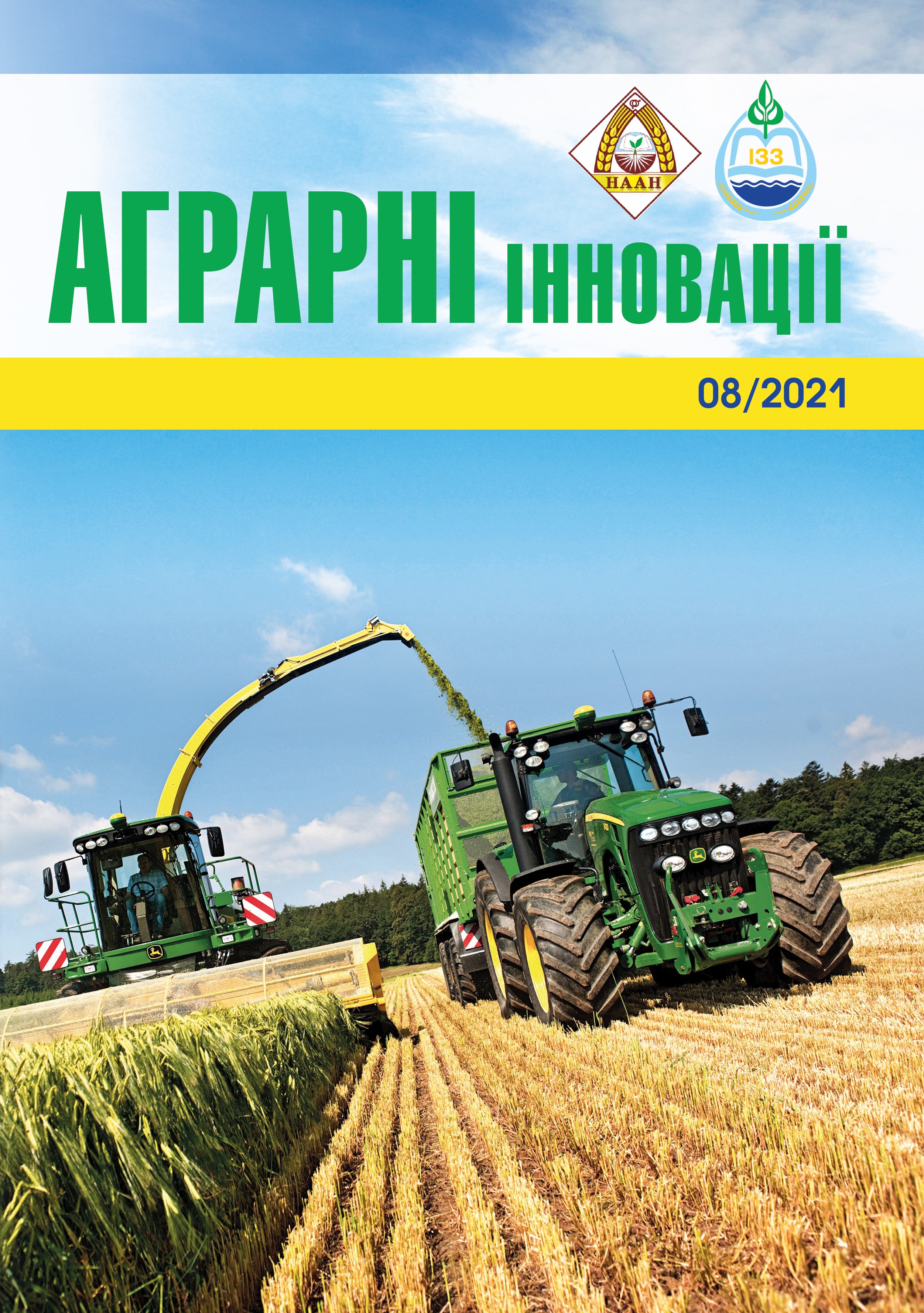Yield of artichoke (Cynara cardunculus L. var. scolymus (L.) Fiori) depending on plant density
Abstract
Purpose. Study and analysis of world experiencein artichoke cultivation at different plant densitiesand the impact of the latter on its productivity. Developmentof a mathematical polynomial model of the crop productivitydepending on its thickening.Methods. Synthetic-analytical method for generalizationof research data obtained in various studies on artichokecultivation technology, mathematical analysis by polynomialregression (polynomial of the second degree) to develop a model of the crop productivity depending on the plantdensity. Graphical approximation of the model by plottinga polynomial of the second degree and building a parabolaof the crop productivity.Results. The developed polynomial model of artichokeproductivity depending on the plant density expressed as"Yield=4.8872+0.0017×Density–3.0162×10-8×Density2"provides sufficient prognostic efficiency (the valueof the mean absolute percentage error of the modelMAPE is 24.59%) and fit quality. Analysis of the resultsof mathematical modeling suggests the need to studythe agrotechnology of artichoke at the densities from 10 to35 thousand/ha. The least promising are artichoke plantdensities in the ranges of 5-10 and more than 35 thousand/ha, which are accompanied by a decrease in the cropproductivity according to the approximation curve.Conclusions. The results of the study indicate thatthe optimal density of artichoke plants depends on growingconditions, however, there is a clear trend to an increase inthe crop yields under conditions of thickening. Mathematicalmodeling has shown that the modal values of the populationof artichoke plants per 1 ha are within10-15 thousand/ha,while the most promising in terms of the crop productivityshould be density values from 20 to 35 thousand/hadepending on agro-climatic conditions and morphobiologicalfeatures of certain variety.
References
2. «Заморский цветок» – артишок. Овочі та Фрукти. 2019. № 121(12). С. 62–63.
3. Sgroi F., Fodera M., Di Trapani A.M., Tudisca S., Testa R. Profitability of artichoke growing in the Mediterranean area. HortScience. 2015. Vol. 50(9). P. 1349–1352.
4. Дышкант Д. Выращиваем артишок в Украине. Овочі та Фрукти. 2019. № 121(12). С. 59–61.
5. Кльош Ю.І., Муж Г.В. Можливості вирощування артишоку посівного (Cynara scolymus) в умовах агробіостанції ЖДУ. Біологічні дослідження – 2012: матеріали конференції. 2012. С. 107–110.
6. Улянич О.І., Вдовенко С.А., Ковтунюк З.І., Кецкало В.В., Слободяник Г.Я., Воробйова Н.В., Сорока Л.В. Кравченко В.С. Біологічні особливості та вирощування малопоширених овочів: навчальний посібник. Умань : «Візаві», 2018. 278 с.
7. Хареба О.В., Горова Т.К., Позняк О.В. Біологоекологічні особливості дво- і багаторічних овочевих рослин родини Айстрові (Asteraceae Dumort). Наукові доповіді НУБіП України. 2019. № 1(77).
8. Leskovar D.I., Xu C., Agehara S. Planting configuration and plasticulture effects on growth, physiology, and yield of globe artichoke. HortScience. 2013. Vol. 48(12). P. 1496–1501.
9. Mauro R.P., Lombardo S., Longo A.M.G., Pandino G., Mauromicale G. New cropping designs of globe artichoke for industrial use. Italian Journal of Agronomy. 2011. Vol. 6(1). P. 44–49.
10. Elia A., Paolicelli F., Bianco V.V. Effect of sowing date, plant density and nitrogen fertilizer on artichoke (Cynara scolymus L.): preliminary results. Advances in Horticultural Science. 1991. Vol. 5. P. 119–122.
11. Kolodziej B., Winiarska S. The effect of selected cultivation methods on yield and quality of artichoke (Cynara scolymus L.) raw material. Acta Scientarum Polonorum. Hortorum Cultus. 2012. Vol. 11(1). P. 171–182.
12. Ierna A., Mauro R.P., Mauromicale G. Biomass, grain and energy yield in Cynara cardunculus L. as affected by fertilization, genotype and harvest time. Biomass & Bioenergy. 2011. Vol. 36. P. 404–410.
13. Ierna A., Mauro R., Mauromicale G. Improved yield and nutrient efficiency in two globe artichoke genotypes by balancing nitrogen and phosphorus supply. Agronomy for Sustainable Development. 2012. Vol. 32(3). P. 773–780.
14. Mauromicale G., Sortino O., Pesce G.R., Agnello M., Mauro R.P. Suitability of cultivated and wild cardoon as a sustainable bioenergy crop for low input cultivation in low quality Mediterranean soils. Industrial Crops and Products. 2014. Vol. 57. P. 82–89.
15. Ostertagova E. Modelling using polynomial regression. Procedia Engineering. 2012. Vol. 48. P. 500–506.
16. Moreno J.J.M., Pol A.P., Abad A.S., Blasco B.C. Using the R-MAPE index as a resistant measure of forecast accuracy. Psicothema. 2013. Vol. 25(4). P. 500–506.
17. Moksony F., Heged R. Small is beautiful. The use and interpretation of R2 in social research. Szociológiai Szemle. 1990. Special issue. P. 130–138.






